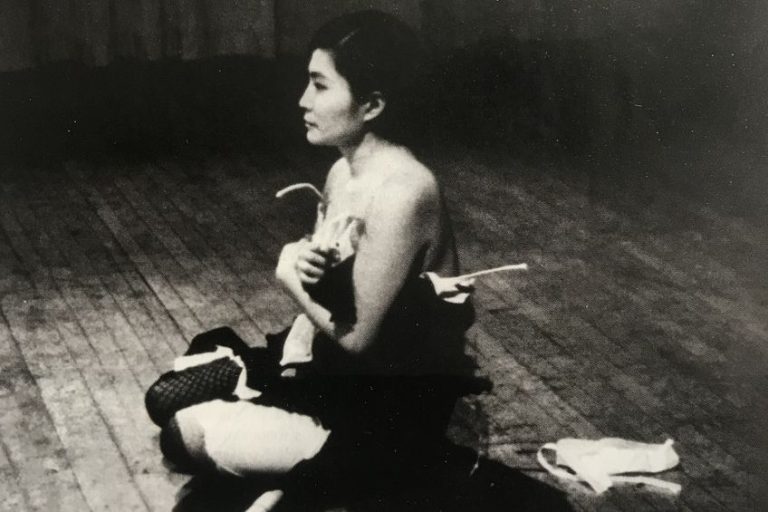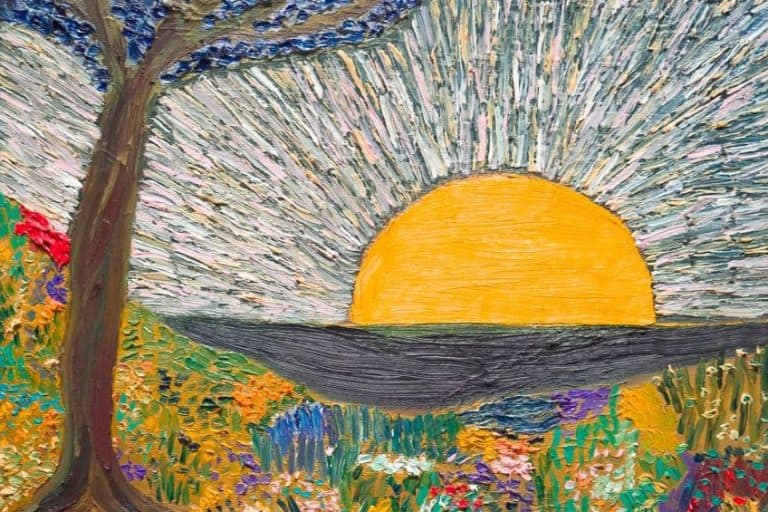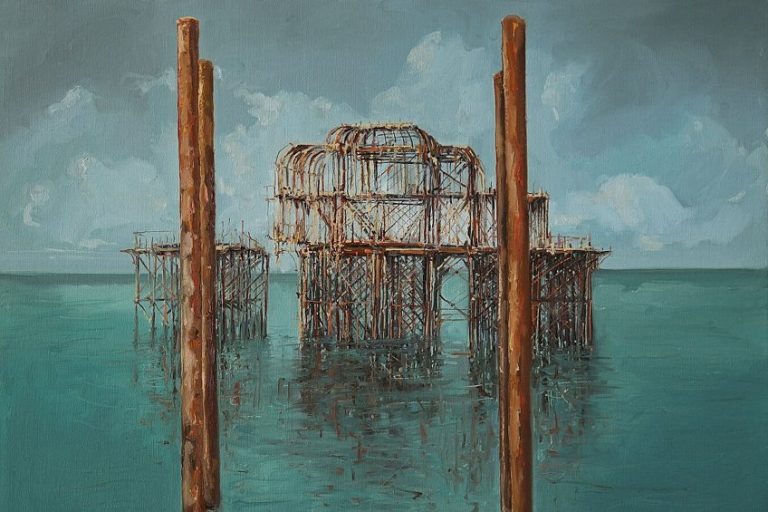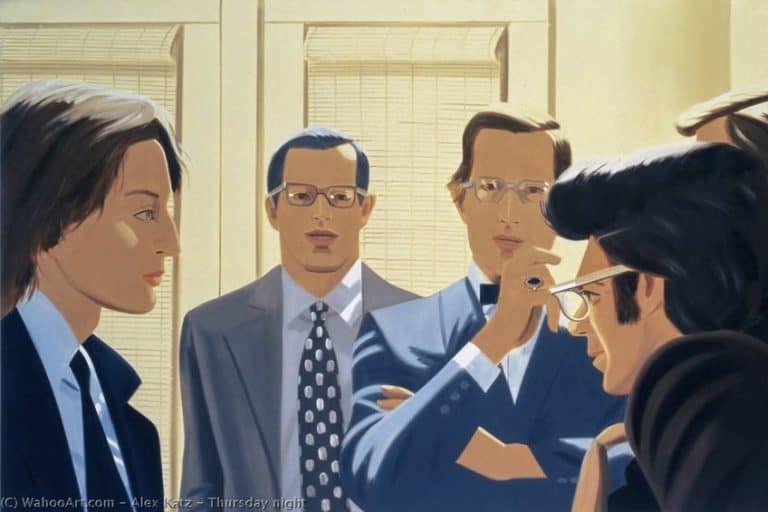Female Japanese Artists – Women in Modern Japanese Art
Japanese art has a rich and diverse history that spans centuries and encompasses a wide range of styles and mediums. Despite the cultural and social challenges that women artists faced in Japan, there have been many notable female artists throughout history who have made significant contributions to the world of art. From traditional Japanese art forms, such as ukiyo-e and calligraphy, to more contemporary works in painting, sculpture, and performance art, these women have left a lasting impact on the art world. In this article, we will explore the lives and works of some of the most famous female Japanese artists, and examine the unique perspectives and techniques that they brought to their craft.
Female Japanese Artists: A Historical Perspective
Japanese art has a rich and diverse history, and the role of women in shaping and influencing this artistic legacy cannot be overstated. From ancient times to the modern era, Japanese women have contributed to the development of various art forms, including painting, calligraphy, and textile arts.
In ancient times, women played a vital role in creating textiles, including weaving and embroidery. Many of these pieces were used in religious ceremonies and were considered valuable treasures. Women also played a significant role in the production of ceramics and pottery, which were used for everyday use as well as for religious and ceremonial purposes.

During the Heian period (794 – 1185), female aristocrats played a significant role in the development of Japanese literature, particularly in the form of poetry. Women such as Murasaki Shikibu (unknown date of birth and death), the author of The Tale of Genji (1008), and Sei Shonagon (966 AD – Unknown), who wrote The Pillow Book (1002), were influential figures in Japanese literature, and their works continue to be studied and admired to this day.
In the Edo period (1603 – 1868), women artists began to emerge in the fields of painting and calligraphy. These women, known as bijin-ga or “beautiful women” painters, depicted scenes of everyday life and the natural world, as well as images of women. These artists were often trained by their fathers or husbands, and many achieved great success and recognition for their work.
In the modern era, women have continued to make significant contributions to Japanese art. Yayoi Kusama (1929 – Present), for example, is a contemporary artist known for her bold, colorful, and often surreal works. Her art has been exhibited all over the world and has inspired countless artists.
Let us look at more significant female Japanese artists.
Kimiko Nishimoto (1928 – Present)
| Date of Birth | 1928 |
| Date of Death | N/A |
| Nationality | Japanese |
| Medium | Photography |
| Famous Artworks | Self-portrait series (2001 – Present) |
| Performance Themes | Joy, playfulness, humor, city-life, and old age |
Kimiko Nishimoto is a Japanese photographer who gained worldwide recognition for her whimsical and playful self-portraits. Nishimoto started her photography career at the age of 72 after taking a beginner’s course. Her photographs are characterized by her unique and humorous approach to self-portraiture, often featuring herself in fantastical and surreal situations.
Why Is Kimiko Nishimoto an Influential Modern Japanese Artist?
Despite starting her career as a painter, it was Kimiko Nishimoto’s experimentation with digital photography at the age of 72 that propelled her to fame. Her playful and imaginative approach to photography has captured the hearts of audiences around the world, with her work being featured in numerous exhibitions and galleries. Nishimoto’s work challenges traditional notions of aging and beauty, and her willingness to embrace new technology and techniques at an older age serves as an inspiration to many.
Her art reminds us to find joy and humor in every day and to never stop exploring our creative potential.
Artwork Example: Self-Portrait Series (2001 – Present)
Kimiko Nishimoto’s self-portraits are a delightful blend of humor and creativity that showcase her unique perspective as an elderly artist. Through her photographs, she explores various whimsical scenarios and scenarios, often featuring herself as the protagonist. Her use of props and costumes adds a touch of theatricality to her images, while her sense of humor injects a lightheartedness that is both charming and endearing. Nishimoto’s portraits also highlight her technical skills as a photographer, as she experiments with composition, lighting, and other elements to create visually striking and memorable images. Overall, her self-portraits are a testament to the power of art to transcend age and societal expectations and to celebrate life’s quirks and joys.
Yayoi Kusama (1929 – Present)
| Date of Birth | 1929 |
| Date of Death | N/A |
| Nationality | Japanese |
| Medium | Multimedia |
| Famous Artworks | Dots Obsession (2003), Infinity Mirror Room (1965 – Present), and Ascension of Polka Dots (2006) |
| Performance Themes | Human mind, feminism, infatuation, lovemaking, creation, destruction, and extreme self-reflection |
Yayoi Kusama is a Japanese artist who has had a profound impact on the international art scene since the 1960s. She is renowned for her vivid use of colors, intricate patterns, and bold, repetitive motifs across a range of artistic media, including painting, sculpture, performance, and installation art. Her works often explore the themes of infinity, obsession, and the human condition, and are influenced by her own struggles with mental health. Kusama’s artistic creations have been exhibited in major museums and galleries globally, and she continues to be a source of inspiration for contemporary artists.
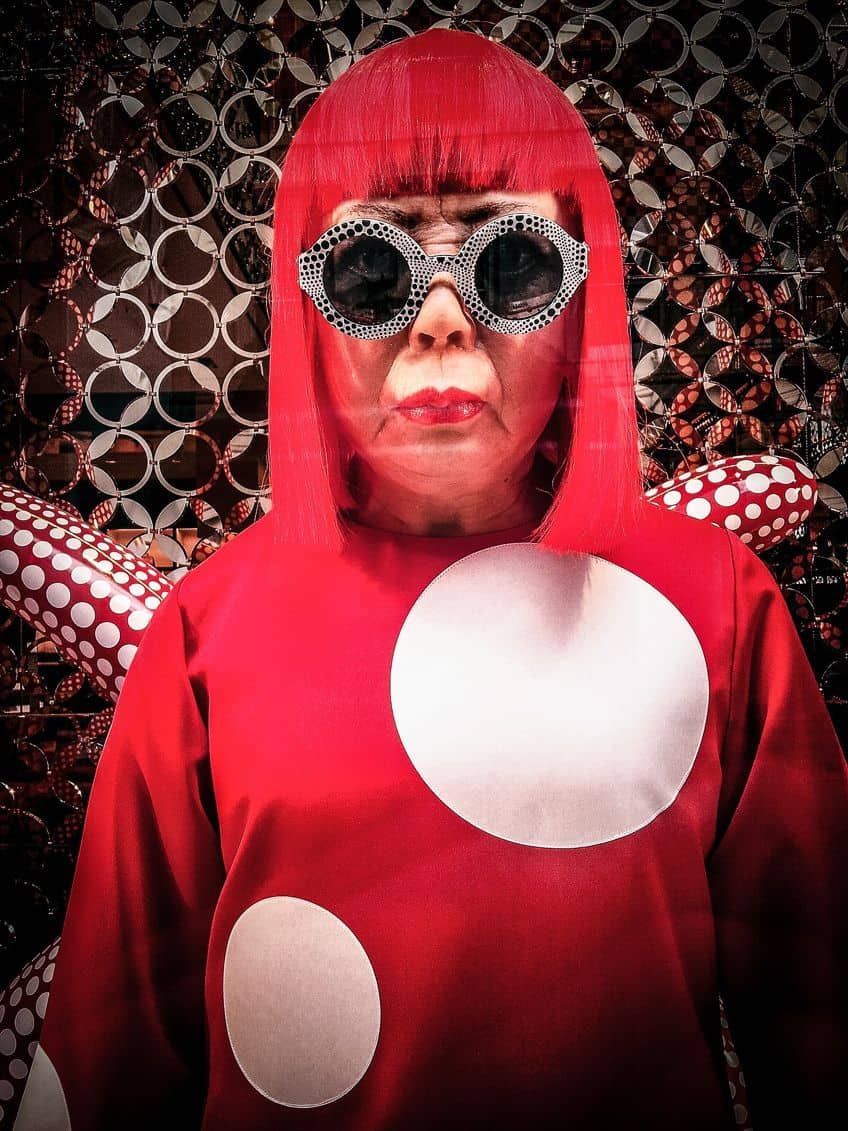
Why Is Yayoi Kusama Such an Influential Modern Japanese Artist?
Kusama’s innovative approach to art has been instrumental in redefining its scope in the contemporary era. Her use of various mediums, particularly installation art, challenges traditional definitions and borders of art. The mesmerizing experiences she creates through her works are immersive, utilizing repetition, bold colors, and abstract forms to transport viewers beyond the ordinary.
Kusama’s art delves into themes of infinity, the subconscious, and personal experience, forging a deep emotional connection with the audience.
Artwork Example: Infinity Mirror Room (1965 – Present)
One of Kusama’s most famous works is the Infinity Mirror Room, which has been in production since 1965. This installation artwork immerses the viewer in an apparently infinite space, with mirrored walls and an array of lights reflected infinitely. The use of repetition and pattern creates a sense of infinity and a feeling of being lost in an endless universe. The work reflects Kusama’s fascination with the cosmos and the infinite possibilities of the human psyche, inviting the viewer to engage with the work on both a visual and conceptual level, providing a meditative and introspective experience.
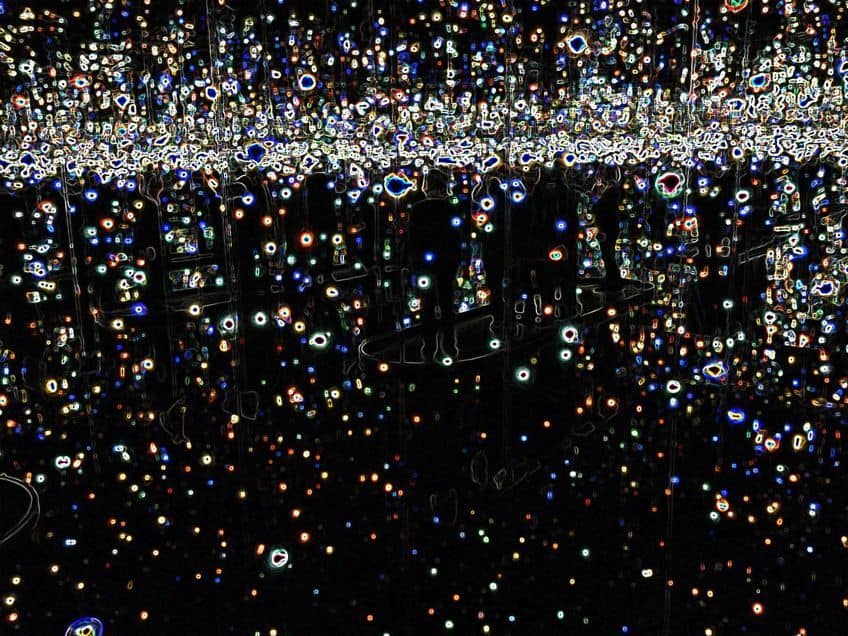
Yoko Ono (1933 – Present)
| Date of Birth | 1933 |
| Date of Death | N/A |
| Nationality | Japanese |
| Medium | Multimedia |
| Famous Artworks | Danger Box (1966), Ceiling Painting (1966), Apple (1966), and Cut Piece (1964) |
| Performance Themes | Pacifism, peace, and interchanges between the viewers and performer |
Yoko Ono, a Japanese artist, musician, and peace activist, has been active in the art world since the 1950s. She is renowned for her multimedia work, including conceptual art, performance art, installation art, and music, and is considered one of the most prolific contributors to the Fluxus movement.

Why Is Yoko Ono Such an Influential Modern Japanese Artist?
Ono’s artwork often features elements of chance and invites viewers to participate in the creation of the artwork. This was a new and revolutionary way of making art when she first started practicing in this way. Initially, this approach led to a lot of controversies but eventually contributed to Ono’s notoriety. She became well-known for her Instruction Paintings (1961-present), which are written instructions for actions or thoughts that can be executed as a form of conceptual art.
Yoko Ono’s marriage to John Lennon and their collaborations in music and art also contributed to her fame.
Artwork Example: Instruction Paintings (1961- Present)
Instruction Paintings (1961 – Present) is a notable example of Ono’s performance art. The work consists of simple, open-ended written instructions, such as “Imagine the sky is the sea” or “Write your name in the air with a brush made of smoke.” The objective of these instructions is to encourage viewers to interact with the artwork in a new way and broaden the possibilities of what art can be. The instruction paintings are not only limited to visual art, but also include musical compositions, poetry, and recipes. The documentation of the executed instructions is regarded as the artwork, which can be performed individually or collectively. These instruction paintings are regarded as a significant work in Ono’s artistic oeuvre and are widely displayed and collected by museums and galleries worldwide.
Yoshiko Shimada (1959 – Present)
| Date of Birth | 1959 |
| Date of Death | N/A |
| Nationality | Japan |
| Medium | Printmaking and Performance art |
| Famous Artworks | Tied to Apron Strings (1993), Comfort/Women/of Conformity (1994 – 1995), Bones in Tansu: Family Secrets (2004), and Becoming a Statue of a Japanese Comfort Woman (2012 – Present) |
| Performance Themes | Power, narrative, gender, and government |
Yoshiko Shimada is a renowned printmaker and performance artist from Japan who has been hailed as a leading feminist and anti-war artist in the country. Her artwork has delved into the themes of gender, history, power, and nationhood, with a focus on her own complex socio-political background as a Japanese, Asian, and female artist.
Shimada grew up near the U.S. Air Force Base in Tachikawa, Tokyo, which shaped her perspective on the post-war tensions between the U.S. and Japan during the 1960s. She attended university in the U.S., before returning to Japan to study etching under Yoshida Katsurō at the Biggakō art school in Tokyo. Shimada has lived in Berlin and New York City and received her Ph.D from Kingston University in London in 2015.
Why Is Yoshiko Shimada an Influential Modern Japanese Artist?
Shimada’s international background, combined with her unique perspective on socio-political issues, has contributed to her reputation as one of Japan’s most important contemporary artists. Shimada’s works have been displayed in numerous exhibitions across Japan and around the world, and she has also curated art exhibitions both domestically and internationally. She is also a lecturer at the University of Tokyo, where she teaches topics such as feminism, politics, and Japanese art.
Through her occupation as a lecturer, she is influencing the new generation of artists to consider feminist and anti-war themes in their work.
Artwork Example: Becoming a Statue of a Japanese Comfort Woman (2012 – Present)
Starting from 2012, Shimada has been presenting a performance titled Becoming a Statue of a Japanese Comfort Woman, previously named Missing. During the first enactment, Shimada put on a Japanese kimono and painted her skin bronze, and stayed in front of the Japanese Embassy in London for around an hour. This action was a reference to the Statue of Peace, a tribute to the enslaved Korean “comfort women” during the Asia-Pacific War. Shimada chose to wear a kimono instead of a traditional Korean hanbok, emphasizing the fact that Japanese women were also forced to become sexual slaves during the war. Since then, Shimada has performed this act on multiple occasions, including controversial locations in Japan like the Yasukuni Shrine and the National Diet, in South Korea, and as part of the feminist art collective Tomorrow Girls Troop in Colorado, United States.
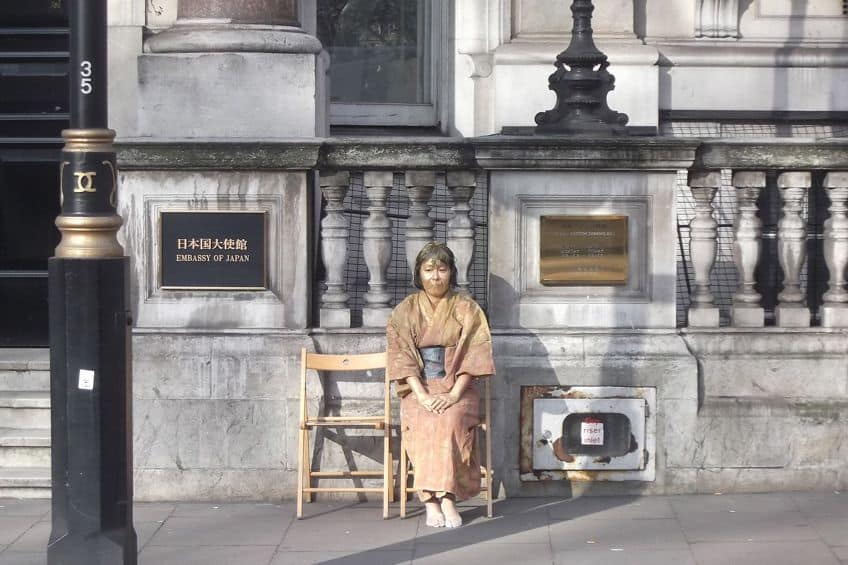
Mariko Mori (1967 – Present)
| Date of Birth | 1967 |
| Date of Death | N/A |
| Nationality | Japanese |
| Medium | Photography, digital art, and sculpture |
| Famous Artworks | Play With Me (1994), Subway (1994), and Empty Dream (1995) |
| Performance Themes | Personal spirituality, staggering technology, feminism, and sexuality |
Mariko Mori is a contemporary Japanese artist known for her unique approach to art-making that blends elements of technology, spirituality, and popular culture. Mori has spent much of her career exploring the intersection of Eastern and Western traditions, using a wide range of mediums including photography, sculpture, installation, video, and performance.
Her work often reflects her interest in Buddhism and the Shinto religion, as well as her fascination with science fiction and other forms of futuristic imagery. With a focus on the transformation of consciousness and the connection between humans and the natural world, Mori’s art offers a thought-provoking commentary on contemporary life and the human condition.

Why Is Mariko Mori an Influential Modern Japanese Artist?
Mariko Mori’s works often explore themes of identity, gender, and environmentalism, while incorporating elements of pop culture and futuristic technology. Through her use of various media including photography, video, sculpture, and performance art, Mori creates immersive experiences that challenge viewers to question their perception of reality and the role of technology in shaping our lives.
Her groundbreaking work has been exhibited in major museums and art institutions around the world, cementing her status as one of the most important Japanese artists of her generation.
Artwork Example: Play with Me (1994)
“Play With Me” (1994) by Mariko Mori is a striking photograph that portrays the artist as a provocative, otherworldly figure or cyborg. Dressed in tight-fitting plastic armor and a flowing blue-green Barbie wig, Mariko stands outside a bustling video store in Tokyo. Her appearance can be described as a fusion of a samurai-like young girl and a mechanical streetwalker who could have emerged from the video game next to her. Overall, “Play With Me” is a visually compelling piece that challenges traditional notions of femininity and identity while exploring themes of technology and futurism.
Megumi Igarashi (1972 – Present)
| Date of Birth | 1972 |
| Date of Death | N/A |
| Nationality | Japanese |
| Medium | Sculpture and manga |
| Famous Artworks | Deco Man (ongoing series) and Man-Boat (2014) |
| Performance Themes | Female body, gender, female sex-organs, activism, sexuality, and feminism |
Megumi Igarashi, also known as Rokudenashiko, is a Japanese artist and activist whose work revolves around challenging taboos and pushing boundaries through the use of sexuality and humor. She is best known for her artwork featuring the vulva, which she uses as a symbol of empowerment and a tool for social commentary.
Through her playful and provocative approach, Igarashi aims to spark conversations and raise awareness about gender and sexuality issues in Japan and beyond. Her work has been met with controversy and censorship, which has only fueled her dedication to promoting freedom of expression and advocating for women’s rights. Igarashi’s art encompasses a range of mediums, from sculpture and installations to drawings and digital media. Her innovative and bold approach to art has made her a prominent figure in the contemporary art world and a leading voice for artistic freedom and sexual liberation.
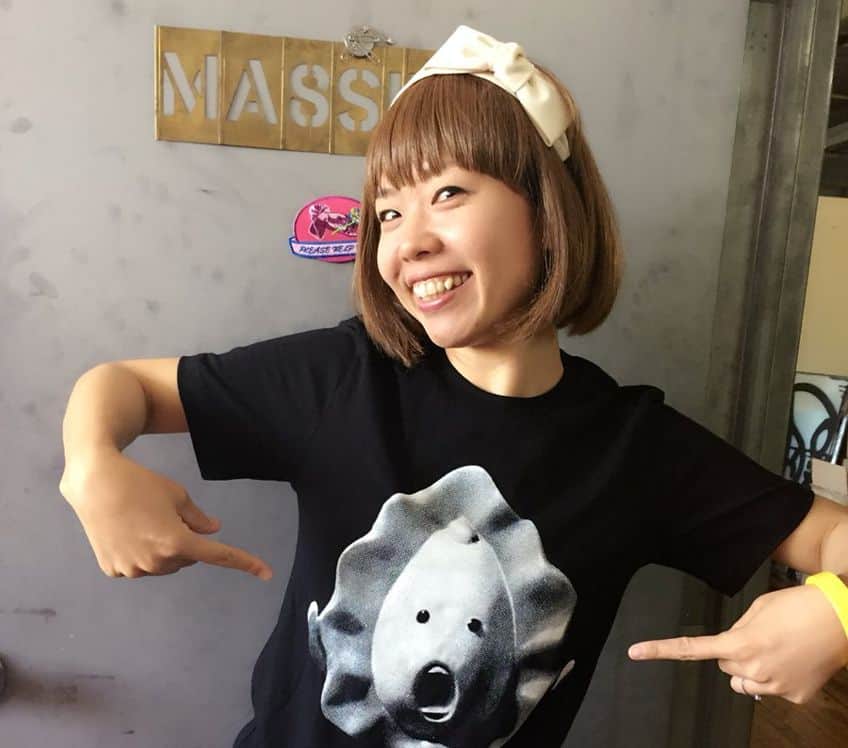
Why Is Megumi Igarashi Such an Influential Modern Japanese Artist?
Megumi Igarashi is a highly influential modern Japanese artist because of her subversive and provocative artwork, which challenges societal norms and expectations around female sexuality and gender.
Through her use of a range of mediums, including sculpture, performance, and digital media, Igarashi explores themes of body positivity, feminism, and censorship.
Artwork Example: Man Boat (2014)
One of her most notable works is the Vagina Boat (Man Boat) (2014) project, in which she created a kayak modeled after her own genitals as a statement against the stigma and taboo around female genitalia in Japanese culture. This project sparked a national conversation about censorship and artistic freedom, and Igarashi’s activism and advocacy have made her a leading figure in the fight for gender equality and sexual liberation in Japan and beyond.
Chiharu Shiota (1972 – Present)
| Date of Birth | 1972 |
| Date of Death | N/A |
| Nationality | Japanese |
| Medium | Installation art and performance art |
| Famous Artworks | Red Line XXIII 紅線13 塩田千春 (2012), Belonging, (2017), and Skin (2017) |
| Performance Themes | Memory, human reality, and banishment |
Chiharu Shiota is a renowned Japanese artist who is internationally recognized for her captivating large-scale installations that explore the themes of memory, human existence, and displacement. Shiota’s signature style involves using thread to create intricate, web-like structures that engulf entire rooms or objects, often incorporating found objects and personal belongings. Her works blur the lines between sculpture, performance, and installation art, creating immersive environments that invite the viewer to contemplate their relationship with their surroundings and the past.
Why Is Chiharu Shiota an Influential Modern Japanese Artist?
Chiharu Shiota is an influential modern Japanese artist known for her immersive installations that explore the themes of memory, loss, and identity. She creates large-scale, intricate works using everyday objects such as keys, shoes, and furniture, which she weaves together using thread or rope. Through her installations, Shiota invites the viewer to engage with the artworks on a visceral level, as they become enveloped in the intricate webs of her creations. Her works have been exhibited in major museums and galleries around the world, including the Museum of Contemporary Art Australia, the Mori Art Museum in Tokyo, and the Venice Biennale.
By pushing the boundaries of installation art and exploring the intersections between art and life, Shiota has established herself as one of the most important and influential artists of her generation.
Artwork Example: Keys (2015)
Chiharu Shiota’s installation piece Keys (2015) features a network of tangled red yarn suspended from the ceiling, with thousands of old keys hanging from the threads at different heights. The keys create a sense of weight and gravity, as if they are holding the delicate web of yarn in place. The installation’s title evokes the idea of keys as symbols of access, control, and power, and the mass of keys in the work suggests a collective history of ownership and use. The tangled web of red yarn, which seems to envelop the viewer, could represent the interconnectedness of human relationships or the complex web of memories and emotions associated with places and things. Overall, the piece invites the viewer to contemplate the mysteries and contradictions of human experiences, such as the tension between individuality and community, and the weight of the past on the present.

Chie Fueki (1973 – Present)
| Date of Birth | 1973 |
| Date of Death | N/A |
| Nationality | Japanese |
| Medium | Painting |
| Famous Artworks | Nikko (2018), Ellen (2017), and Where (2017) |
| Performance Themes | Mythology, nature, personal experience, and symbolism |
Chie Fueki is a contemporary Japanese-American artist known for her vibrant and enigmatic paintings. Her works are a fusion of Eastern and Western influences, combining elements of traditional Japanese art with contemporary American painting styles. Fueki’s paintings often feature a layered and complex composition, with hidden imagery and symbols that invite the viewer to engage with the work on a deeper level.
She draws inspiration from a range of sources, including mythology, nature, and personal experiences, to create narratives that blur the lines between reality and fantasy. Through her unique style and approach to painting, Fueki has established herself as an important voice in the contemporary art world. Her works have been exhibited in numerous solo and group exhibitions in the United States and abroad, and are held in the collections of major museums and institutions.
Why Is Chie Fueki Such an Influential Modern Japanese Artist?
Chie Fueki is considered an influential modern Japanese artist for several reasons. Her works represent a unique fusion of Eastern and Western artistic traditions, demonstrating a profound understanding of both cultures. Fueki’s approach to painting is characterized by a masterful use of color, composition, and symbolism that draws the viewer into a world of mystery and intrigue. Her paintings invite viewers to explore the complexities of the human experience and contemplate the relationship between reality and imagination. Fueki’s contribution to contemporary art has been recognized through numerous exhibitions, awards, and critical acclaim.
Her works continue to inspire and captivate audiences worldwide, solidifying her status as one of the most influential modern Japanese artists of her generation.
Exhibition Example: You and I (2022)
Fueki’s exhibition You and I challenge the Western oil painting tradition and the concept of a masterpiece, by using acrylic and collage on mulberry paper, which is mounted on wood. The portraits in the group of five are about the self and other, without reference to gender as defined by mainstream culture.
The only face visible is in the mirror of Finally Bridget (2021), which depicts the artist’s friend after her gender transition. The paintings use culturally coded images and perspectival systems, and feature radiating lines, patterns, and force fields. Fueki’s meticulous, hands-on approach is apparent in every aspect of her work, with nothing feeling extraneous or unconsidered.
Although her approach might seem old-fashioned in a time of fabrication and outsourcing, the pleasure of making is evident in Fueki’s art, which is both a celebration and a portrait. Her collapsing of work and pleasure challenges the mainstream’s obsession with sybaritic leisure and the selfies that record it.
Tabaimo (1975 – Present)
| Date of Birth | 1975 |
| Date of Death | N/A |
| Nationality | American |
| Medium | Drawing, digital art, video, and installation |
| Famous Artworks | Hunger Flower (2015), public conVENience (2006), and Seattle Art Museum (2017) |
| Performance Themes | Seclusion, contagion, and flux |
Tabaimo is a contemporary Japanese artist known for her innovative and thought-provoking multimedia works, including video installations, drawings, and prints. Her works often explore themes of identity, technology, and contemporary society, combining traditional Japanese art styles with a modern twist.
Why Is Tabaimo an Influential Modern Japanese Artist?
Tabaimo is particularly renowned for her intricate and detailed hand-drawn animations that depict fantastical and surreal scenes, often featuring everyday objects and architecture.
Tabaimo’s works have been widely exhibited in major museums and galleries around the world, and she has received numerous accolades for her contributions to contemporary art.
Artwork Example: Hunger Flower (2015)
Hunger Flower (2015) by Tabaimo is a mixed media installation that explores the theme of desire and consumption in contemporary society. The artwork is composed of a large video projection of a blooming flower, with its petals made of human fingers. The flower is constantly in motion, its petals opening and closing, while eerie sounds fill the space.
As the petals open, we see a dark, cavernous void inside, suggesting a hunger or a desire that cannot be fulfilled. The fingers are reminiscent of the traditional Japanese ghost stories, in which spirits manifest themselves as body parts. The use of mixed media, including video projection and sculptural elements, creates an immersive and unsettling environment. Hunger Flower can be seen as a commentary on the excess and insatiability of contemporary consumer culture, as well as the hidden, darker aspects of human desire.
In conclusion, the impact of female Japanese artists in contemporary art cannot be understated. From Mariko Mori’s exploration of spirituality and technology to Yoshiko Shimada’s politically charged performances, these artists have pushed the boundaries of what art can be and opened up new avenues of artistic expression. Their contributions have not only shaped the Japanese art scene but also influenced the global art world. The work of these artists continues to inspire and challenge viewers, and their legacies will undoubtedly endure for years to come.
Frequently Asked Questions
How Has Female Japanese Art Evolved over the Years?
The evolution of female Japanese art has been a long and rich one, with women contributing to various art forms throughout history. From textile arts to literature and painting, Japanese women have left an indelible mark on the artistic legacy of Japan, and their contributions continue to be celebrated and admired to this day.
Who Are the Most Prominent Female Japanese Artists?
There are many prominent female Japanese artists whose contributions have greatly impacted the world of contemporary art. Yayoi Kusama (1929 – Present) is perhaps the most well-known and influential, with her unique style and installations that have captivated audiences around the world. Other notable artists include Chiharu Shiota (1972 – Present), known for her large-scale installations that explore themes of memory and the human condition, and Mariko Mori (1967 – Present), whose work combines traditional Japanese aesthetics with futuristic technology. Yoshiko Shimada (1959 – Present) is another important feminist artist whose performance pieces challenge social and political norms. Kimiko Nishimoto’s (1975 – Present) playful and humorous self-portraits have also gained international recognition in recent years. Together, these female artists have helped shape the art world and inspire future generations of artists.
Have Female Japanese Artists Been Represented the Same As Male Japanese Artists?
Like many other countries, female Japanese artists have struggled for equal representation and recognition in the art world. Historically, male artists dominated the Japanese art scene, and women were often excluded from art education and exhibitions. Even today, female artists still face barriers to achieving success and recognition in the industry. However, in recent years, there has been a growing recognition of the contributions of female Japanese artists, and efforts to promote their work and increase their visibility have been made. Despite the ongoing challenges, female Japanese artists continue to create impactful and innovative work that pushes boundaries and challenges societal norms.
Isabella studied at the University of Cape Town in South Africa and graduated with a Bachelor of Arts majoring in English Literature & Language and Psychology. Throughout her undergraduate years, she took Art History as an additional subject and absolutely loved it. Building on from her art history knowledge that began in high school, art has always been a particular area of fascination for her. From learning about artworks previously unknown to her, or sharpening her existing understanding of specific works, the ability to continue learning within this interesting sphere excites her greatly.
Her focal points of interest in art history encompass profiling specific artists and art movements, as it is these areas where she is able to really dig deep into the rich narrative of the art world. Additionally, she particularly enjoys exploring the different artistic styles of the 20th century, as well as the important impact that female artists have had on the development of art history.
Learn more about Isabella Meyer and the Art in Context Team.
Cite this Article
Isabella, Meyer, “Female Japanese Artists – Women in Modern Japanese Art.” Art in Context. April 26, 2023. URL: https://artincontext.org/female-japanese-artists/
Meyer, I. (2023, 26 April). Female Japanese Artists – Women in Modern Japanese Art. Art in Context. https://artincontext.org/female-japanese-artists/
Meyer, Isabella. “Female Japanese Artists – Women in Modern Japanese Art.” Art in Context, April 26, 2023. https://artincontext.org/female-japanese-artists/.



